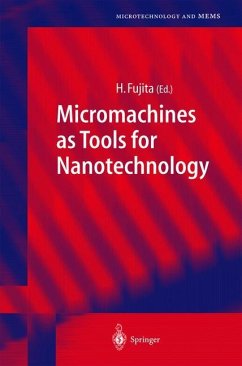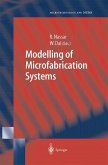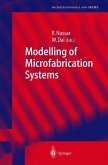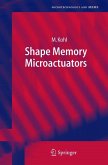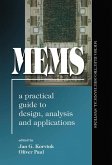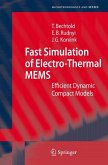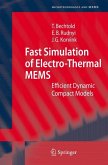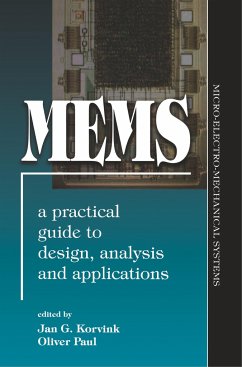- Gebundenes Buch
- Merkliste
- Auf die Merkliste
- Bewerten Bewerten
- Teilen
- Produkt teilen
- Produkterinnerung
- Produkterinnerung
This book addresses the use of MEMS and micromachined devices for the investigation of nanoscience and technology, as well as biotechnology. Such micromachined tools for nanotechnology can enhance the sensitivity, spatial resolution, dexterity, selectivity, and parallel processing capability in measuring and manipulating nano-objects. The book covers state-of-the-art MEMS and NEMS devices for DNA molecular handling and analysis, cell handling and culture on a chip, chemical lab-on-a-chip, multi-probes for vacuum tunneling microscopy and AFM, and characterization of quantum semiconductor…mehr
Andere Kunden interessierten sich auch für
![Modelling of Microfabrication Systems Modelling of Microfabrication Systems]() Raja NassarModelling of Microfabrication Systems112,99 €
Raja NassarModelling of Microfabrication Systems112,99 €![Modelling of Microfabrication Systems Modelling of Microfabrication Systems]() Raja NassarModelling of Microfabrication Systems115,99 €
Raja NassarModelling of Microfabrication Systems115,99 €![Shape Memory Microactuators Shape Memory Microactuators]() Manfred KohlShape Memory Microactuators115,99 €
Manfred KohlShape Memory Microactuators115,99 €![MEMS: A Practical Guide of Design, Analysis, and Applications MEMS: A Practical Guide of Design, Analysis, and Applications]() Jan KorvinkMEMS: A Practical Guide of Design, Analysis, and Applications149,99 €
Jan KorvinkMEMS: A Practical Guide of Design, Analysis, and Applications149,99 €![Fast Simulation of Electro-Thermal MEMS Fast Simulation of Electro-Thermal MEMS]() Tamara BechtoldFast Simulation of Electro-Thermal MEMS75,99 €
Tamara BechtoldFast Simulation of Electro-Thermal MEMS75,99 €![Fast Simulation of Electro-Thermal MEMS Fast Simulation of Electro-Thermal MEMS]() Tamara BechtoldFast Simulation of Electro-Thermal MEMS98,99 €
Tamara BechtoldFast Simulation of Electro-Thermal MEMS98,99 €![MEMS: A Practical Guide of Design, Analysis, and Applications MEMS: A Practical Guide of Design, Analysis, and Applications]() Jan KorvinkMEMS: A Practical Guide of Design, Analysis, and Applications150,99 €
Jan KorvinkMEMS: A Practical Guide of Design, Analysis, and Applications150,99 €-
-
-
This book addresses the use of MEMS and micromachined devices for the investigation of nanoscience and technology, as well as biotechnology. Such micromachined tools for nanotechnology can enhance the sensitivity, spatial resolution, dexterity, selectivity, and parallel processing capability in measuring and manipulating nano-objects. The book covers state-of-the-art MEMS and NEMS devices for DNA molecular handling and analysis, cell handling and culture on a chip, chemical lab-on-a-chip, multi-probes for vacuum tunneling microscopy and AFM, and characterization of quantum semiconductor structures. Readers will gain deep insight into such developments and students will learn about the emerging field of MEMS and nanotechnology.
Produktdetails
- Produktdetails
- Microtechnology and MEMS
- Verlag: Springer / Springer Berlin Heidelberg / Springer, Berlin
- Artikelnr. des Verlages: 978-3-540-00856-9
- 2003
- Seitenzahl: 224
- Erscheinungstermin: 11. Juli 2003
- Englisch
- Abmessung: 241mm x 160mm x 17mm
- Gewicht: 454g
- ISBN-13: 9783540008569
- ISBN-10: 354000856X
- Artikelnr.: 12148881
- Herstellerkennzeichnung Die Herstellerinformationen sind derzeit nicht verfügbar.
- Microtechnology and MEMS
- Verlag: Springer / Springer Berlin Heidelberg / Springer, Berlin
- Artikelnr. des Verlages: 978-3-540-00856-9
- 2003
- Seitenzahl: 224
- Erscheinungstermin: 11. Juli 2003
- Englisch
- Abmessung: 241mm x 160mm x 17mm
- Gewicht: 454g
- ISBN-13: 9783540008569
- ISBN-10: 354000856X
- Artikelnr.: 12148881
- Herstellerkennzeichnung Die Herstellerinformationen sind derzeit nicht verfügbar.
Hiroyuki Fujita, University of Tokyo, Japan
1 Micromachining Tools for Nanosystems.- 1.1 Introduction.- 1.2 Bottom-Up and Top-Down Approaches.- 1.3 Combining the Two Approaches to Nanosystems.- 1.4 Micro- and Nanomachining.- 1.5 Examples of Micromachined Nanodevices.- 1.6 Organization of the Book.- References.- 2 Microsystems for Single-Molecule Handling and Modification.- 2.1 Stretch-and-Positioning of DNA.- 2.2 Molecular Surgery of DNA.- 2.3 A Microfabricated Probe for Molecular Surgery.- 2.4 Conclusion.- References.- 3 Manipulation of Single DNA Molecules.- 3.1 Manipulation of Giant DNA Molecules.- 3.2 Stretching a Giant DNA Molecule.- 3.3 Mapping Stretched Single DNA Molecules.- 3.4 Cutting Stretched DNA.- 3.5 Recovery of DNA Fragments.- 3.6 Microreactors for DNA Manipulation.- 3.7 Conclusion.- References.- 4 Near-Field Optics in Biology.- 4.1 Breaking the Diffraction Barrier.- 4.2 SNOAM Probe Design.- 4.3 SNOAM Configurations.- 4.4 Feedback Mechanisms for SNOAM.- 4.5 SNOAM in Aqueous Environments.- 4.6 SNOAM System Design.- 4.7 Calibration.- 4.8 Fluorescence Imaging with SNOAM.- 4.9 SNOAM Imaging of Fluorescent Beads.- 4.10 Fluorescence Profiling.- 4.11 SNOAM Imaging of Chromosomes.- 4.12 SNOAM Imaging of Recombinant Bacterial Cells Containing a Green Fluorescent Protein Gene.- 4.13 Imaging of Neurons.- 4.14 Future Development of SNOAM.- 4.15 Conclusion.- References.- 5 Atomic Force Microscopy for Imaging Living Organisms: From DNA to Cell Motion.- 5.1 Principles of Atomic Force Microscopy.- 5.2 Applications in Biology.- 5.3 Other SPM Applications in Biology.- 5.4 Conclusion.- References.- 6 Expanding the Field of Application of Scanning Probe Microscopy.- 6.1 Nanotribology.- 6.2 Control.- 6.3 Fabrication.- 6.4 Characterization.- 6.5 Conclusion.- References.- 7 Micromachined Scanning Tunneling Microscopes and Nanoprobes.- 7.1 Operating Principles and Basic Structure.- 7.2 Micro-STM Design Considerations.- 7.3 Surface Micromachining and Bulk Micromachining.- 7.4 Micro-STM Fabrication Technology.- 7.5 Characterization of the Fabricated Micro-STM.- 7.6 Possible Applications of Micromachine STM Technology.- 7.7 Conclusion.- References.- 8 Nanoscale Characterization of Nanostructures and Nanodevices by Scanning Probe Microscopy.- 8.1 Micromachining Technologies in SPM.- 8.2 Scanning Tunneling Microscopy and Spectroscopy for Semiconductors.- 8.3 Atomic Force Microscopy (AFM) on Semiconductor Nanostructures.- 8.4 Scanning Near-field Optical Microscopy (SNOM).- 8.5 Nanofabrication Processes Using STM/AFM.- 8.6 Concluding Remarks.- References.
1 Micromachining Tools for Nanosystems.- 1.1 Introduction.- 1.2 Bottom-Up and Top-Down Approaches.- 1.3 Combining the Two Approaches to Nanosystems.- 1.4 Micro- and Nanomachining.- 1.5 Examples of Micromachined Nanodevices.- 1.6 Organization of the Book.- References.- 2 Microsystems for Single-Molecule Handling and Modification.- 2.1 Stretch-and-Positioning of DNA.- 2.2 Molecular Surgery of DNA.- 2.3 A Microfabricated Probe for Molecular Surgery.- 2.4 Conclusion.- References.- 3 Manipulation of Single DNA Molecules.- 3.1 Manipulation of Giant DNA Molecules.- 3.2 Stretching a Giant DNA Molecule.- 3.3 Mapping Stretched Single DNA Molecules.- 3.4 Cutting Stretched DNA.- 3.5 Recovery of DNA Fragments.- 3.6 Microreactors for DNA Manipulation.- 3.7 Conclusion.- References.- 4 Near-Field Optics in Biology.- 4.1 Breaking the Diffraction Barrier.- 4.2 SNOAM Probe Design.- 4.3 SNOAM Configurations.- 4.4 Feedback Mechanisms for SNOAM.- 4.5 SNOAM in Aqueous Environments.- 4.6 SNOAM System Design.- 4.7 Calibration.- 4.8 Fluorescence Imaging with SNOAM.- 4.9 SNOAM Imaging of Fluorescent Beads.- 4.10 Fluorescence Profiling.- 4.11 SNOAM Imaging of Chromosomes.- 4.12 SNOAM Imaging of Recombinant Bacterial Cells Containing a Green Fluorescent Protein Gene.- 4.13 Imaging of Neurons.- 4.14 Future Development of SNOAM.- 4.15 Conclusion.- References.- 5 Atomic Force Microscopy for Imaging Living Organisms: From DNA to Cell Motion.- 5.1 Principles of Atomic Force Microscopy.- 5.2 Applications in Biology.- 5.3 Other SPM Applications in Biology.- 5.4 Conclusion.- References.- 6 Expanding the Field of Application of Scanning Probe Microscopy.- 6.1 Nanotribology.- 6.2 Control.- 6.3 Fabrication.- 6.4 Characterization.- 6.5 Conclusion.- References.- 7 Micromachined Scanning Tunneling Microscopes and Nanoprobes.- 7.1 Operating Principles and Basic Structure.- 7.2 Micro-STM Design Considerations.- 7.3 Surface Micromachining and Bulk Micromachining.- 7.4 Micro-STM Fabrication Technology.- 7.5 Characterization of the Fabricated Micro-STM.- 7.6 Possible Applications of Micromachine STM Technology.- 7.7 Conclusion.- References.- 8 Nanoscale Characterization of Nanostructures and Nanodevices by Scanning Probe Microscopy.- 8.1 Micromachining Technologies in SPM.- 8.2 Scanning Tunneling Microscopy and Spectroscopy for Semiconductors.- 8.3 Atomic Force Microscopy (AFM) on Semiconductor Nanostructures.- 8.4 Scanning Near-field Optical Microscopy (SNOM).- 8.5 Nanofabrication Processes Using STM/AFM.- 8.6 Concluding Remarks.- References.

